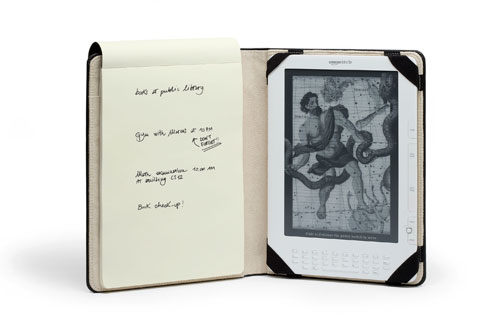E-book V. Print

But now that Moleskine has released a new “analog-digital hybrid,” a half-notebook, half-Kindle-holder creation, I’m a bit worried.
Moleskine, the company that creates those notoriously classy, black-covered and elastic-bound notebooks made famous by artists such as Picasso and Hemingway, is the book worshipper’s best and most beautiful friend. Being a loyal Moleskine user myself, I always assumed that the company would adopt a staunchly pro-print attitude when it came down to the digital vs. print debate. But this latest item has shaken my confidence.
What it comes down to is that companies must keep up with progress if they’re intent on surviving. I can’t honestly say that this wasn’t a smart move for Moleskine; it will probably keep many of its loyal following even more loyal and satisfied, as well as allow the company to gain more customers.
But just how far can culture progress before giving way to convenience? Can the two peacefully coincide, or are we heading toward eliminating what precious human traditions our lightning-paced society has? Will physically walking through a bookstore, choosing a book from the shelf, feeling the weight of the pages in your hands and purchasing it to be your companion for the next few days or weeks soon be an experience of the past?
The Kindle itself sure is progressing. About three weeks ago, it was priced at a whopping $259. As of July 1, Amazon sold out of Kindles on Woot, priced at $149 each. By the end of the year, the Kindle may very well drop to a $99 price point. When this kind of “convenience” is made even more affordable, what’s being improved upon (in this case, physical books) faces a very bleak future.
Our fast-paced society may be turned off by the idea of the e-book taking longer to read. In a recent usability survey by the Nielsen Norman Group, the results showed that the iPad decreased reading speed by 6.2 percent, and the Kindle by 10.7 percent (when compared to printed text). This does not make for the happy student (or professor!). And that is the only case in which I would consider adopting the e-book reader—for the ease in carrying “textbooks” to class. But for my own personal and cultural enrichment, the digital reader will never be for me. And realistically, I can’t see myself gleaning academic information all that well when the physical action of highlighting or underlining is no longer an option.
To be honest, even if it took half the time to read a digital book than it did to read the real deal, I’d still be loyally pro-print. There is some sort of baffling intimacy about holding a book in your hands; noticing the weight of the various dimensions of books you have in your collection; feeling the thin paper between your fingers as you turn the page; carefully dragging a pen under the words that seem to be speaking to some part of you that you knew was there before, but could never quite reach on your own.
Digital readers may be the future, but real books are romance incarnate. I can only hope that the old souls who cling to print, like myself, won’t end up completely devoid of options.
To reach Kelly Baron, click here.



